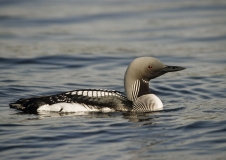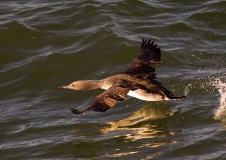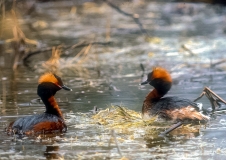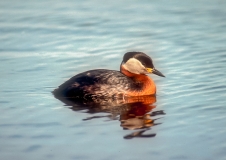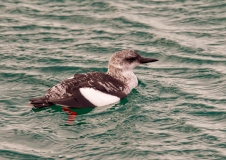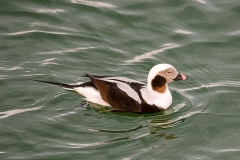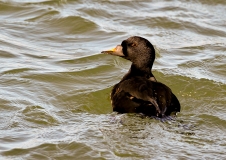The Pomeranian Bay Special Protection Area – Area IV
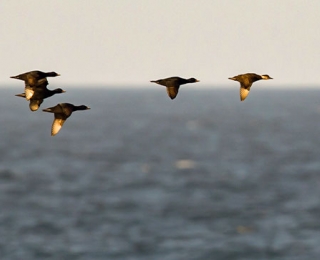
Important characteristics of the protected area
The Pomeranian Bay Special Protection Area is the most important wintering area for divers, grebes and various sea ducks
Die als Seetaucher Black-throated and red-throated divers (Gavia arctica and Gavia stellata), which are often simply summed up as divers, have their most important wintering area within the German EEZ of the Baltic Sea in the Pomeranian Bay, as do red-necked grebes (Podiceps grisegena). Up to 10% of the north-west European population of horned grebes (Podiceps auritus), long-tailed ducks, common scoters and velvet scoters overwinter or rest in this area.
Many other key species (see table below) use the area in different seasons as a resting area, and above all as a feeding habitat.
To safeguard the survival and reproduction of the above-mentioned seabird species as well as their habitats, it is especially necessary to maintain and restore:
- The qualitative and quantitative development of the bird species with the aim of achieving a favourable conservation status, taking into account the natural dynamics and development of populations; special consideration has to be given to birds species with a negative development of their biogeographical population
- The essential direct and indirect food sources of the bird species, especially natural population densities, age class distributions and distribution patterns of the organisms serving the bird species as food sources
- The increased biological productivity that characterises the area at the vertical front formations and the geo-hydromorphological characteristics with their species-specific ecological functions and effects
- Non-separated habitats in the Nature Conservation Area with their individual species-specific ecological functions, spatial interrelations, and unimpeded access to bordering and neighbouring sea areas
- The natural quality of the habitats, especially their protection from pollution and disturbances, and protection of the bird populations from substantial nuisances.
Key species in the protected area
|
Red-throated diver |
Gavia stellata |
|
Black-throated diver |
Gavia arctica |
|
White-billed diver |
Gavia adamsii |
|
Red-necked grebe |
Podiceps grisegena |
|
Horned grebe |
Podiceps auritus |
|
Long-tailed duck |
Clangula hyemalis |
|
Common scoter |
Melanitta nigra |
|
Velvet scoter |
Melanitta fusca |
|
Razorbill |
Alca torda |
|
Common murre |
Uria aalge |
|
Black guillemot |
Cepphus grylle |
|
Mew gull |
Larus canus |
Most important wintering area for divers, grebes and various sea ducks
Black-throated and red-throated divers (Gavia arctica and Gavia stellata), which are often simply summed up as divers, have their most important wintering area within the German EEZ of the Baltic Sea in the Pomeranian Bay, as do red-necked grebes (Podiceps grisegena). Up to 10% of the north-west European population of horned grebes (Podiceps auritus), long-tailed ducks, common scoters and velvet scoters overwinter or rest in this area.
Many other key species (see table below) use the area in different seasons as a resting area, and above all as a feeding habitat.
Importance of the protected area
Importance of the protected area as exemplified by several sea ducks:
In winter and spring, long-tailed ducks are to be found in very high numbers in large areas of the German Baltic Sea. The birds mainly migrate into the German Baltic Sea from the end of October to the beginning of December. In winter (December - February), the largest coherent residence area of the long-tailed ducks is the sea area of Adler Ground with its outstanding blue mussel banks up to the flat grounds of Odra Bank. Up to 140,000 individuals then stay in Area IV, which corresponds to a very large proportion of the overwintering populations of the German Baltic Sea. They use the good feeding conditions to fill up their fat reserves after the exhausting breeding and migration times. The return migration to the breeding areas starts at the beginning of February and reaches its maximum from the end of March to the end of April.
But long-tailed ducks are increasingly becoming distressed. Investigations by international scientific teams show that populations of the formerly most common sea duck have steadily declined in recent decades. Comparisons between the years 1992/1993 and 2007 - 2009 show an alarming 65% decline in the western-Siberian/north-European population from 4.1 million to 1.5 million individuals. This trend also continued after 2010. Currently, it is not known if too low breeding success or too high mortality are primarily responsible for this decline. However, long-tailed ducks are threatened by various factors in their breeding, resting and wintering areas. Research findings show that a high proportion of adult and thus reproductive individuals overwinter in the German Baltic Sea. Germany thus has an especially high degree of responsibility for the protection of this species, as the survival rate of the adult birds is a very important factor in the conservation of the populations.
In winter, common scoters are widely distributed across the German Baltic Sea. In spring (March - May), they are mainly found at Odra Bank. From December to February, up to 50,000 individuals overwinter here and in spring up to 220,000 stay in the protected area. In summer (June - September), Pomeranian Bay is also regarded as an important moulting area for common scoters with around 125,000 of these black beauties gathering in this area.
Velvet scoters also have a very dark colouring but a white patch on the wing and a white spot in the area of the eyes are the differentiating features from the common scoters. In winter, about 55,000 velvet scoters stay in Pomeranian Bay and in spring up to 70,000. The moulting population fluctuates strongly and sometimes amounts to several hundred individuals.
